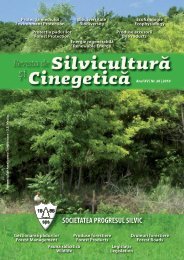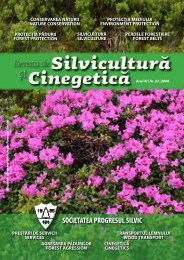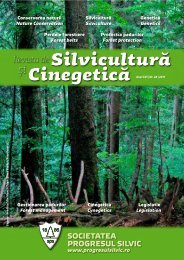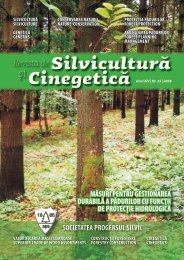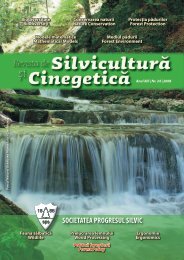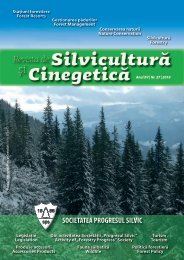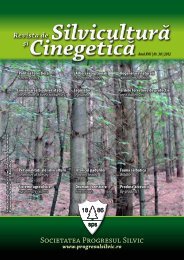Silviculture and Cinegetics Review - Societatea Progresul Silvic
Silviculture and Cinegetics Review - Societatea Progresul Silvic
Silviculture and Cinegetics Review - Societatea Progresul Silvic
You also want an ePaper? Increase the reach of your titles
YUMPU automatically turns print PDFs into web optimized ePapers that Google loves.
FORESTRY BELTS SILVICULTURE AND CINEGETICS REVIEW XVII/30/2012<br />
Table 10. Important aspects of environment protection in dehesa (by Olea <strong>and</strong> San Miguel, 2006)<br />
Role<br />
The most important service offered, but one indirect one is environmental protection. It is required by society<br />
<strong>and</strong> considered a fundamental goal by public opinion (European Community, Spain, Autonomous<br />
Communities), even though most dehesa are private property. The so-called “environmental fee” of dehesa is<br />
high <strong>and</strong> growing.<br />
Protected species Iberian imperial eagle (Aquila adalberti), Hiera aetus fasciatus, Elanus caeruleus, Iberian lynx (Lynx pardinus),<br />
black eagle (Aegypius monachus), black stork (Ciconia nigra), crane (Grus grus), Cabrera mouse (Microtus<br />
cabrerae) <strong>and</strong> many other species, including invertebrates.<br />
Other services<br />
Biological <strong>and</strong> population diversity: α, β, γ<br />
Environmental stability: erosion, climate, biogeochemical cycles of water <strong>and</strong> nutrients, protection against fire<br />
etc.<br />
Genetic diversity: genetic fund for livestock, traditional varieties of the agrosystems characteristic species,<br />
ecotypes of pastures selected by grazing along the centuries.<br />
L<strong>and</strong>scape. Cultural heritage.<br />
3. Traditional agroforestry components<br />
The st<strong>and</strong> stability, as well as the percentage of area<br />
covered by natural or sown pasture ecosystems, or<br />
covered with shrubs, are directly related to erosion in<br />
the dehesa. The arrival of autumn rains brings with it<br />
the appearance of erosion, which is why the use of<br />
appropriate l<strong>and</strong> use contributes significantly to soils<br />
conservation.<br />
3.1. Woody vegetation influence on microclimate<br />
In a stationary of Vlădeasa Massif, at 1100 m altitude,<br />
on the Floroiu peak, at the floor of spruce-beech with<br />
Oxalis <strong>and</strong> secondary grassl<strong>and</strong>s of Agrostis tenuis with<br />
Festuca rubra, early ivaded by Nardus stricta, on<br />
brown podzolic soils, was determined the air <strong>and</strong> soil<br />
termic regime for the vegetation period (Table 11)<br />
Table 11. Average temperature (°C) of air <strong>and</strong> soil in the forest (Fr.) <strong>and</strong> grassl<strong>and</strong> (Gl.) during vegetation period at 1100 m<br />
altitude in Apuseni Mountains(By Maruşca <strong>and</strong> Filip, 1995)<br />
Thermometers location<br />
(cm)<br />
7 o’clock 13 o’clock<br />
Difference hours 13 - 7<br />
Fr. Gl. Diff. Fr. Gl. Diff. Fr. Gl.<br />
Air +200 9.3 10.7 -1.4 13.8 13.8 0.0 +4.5 +3.1<br />
+150 9.0 10.7 -1.7 13.7 15.2 -1.5 +4.7 +4.5<br />
+100 9.4 9.9 -0.5 13.7 15.4 -1.7 +4.3 +5.5<br />
+ 60 9.2 10.1 -0.9 13.4 16.6 -3.2 +4.2 +6.5<br />
+ 30 9.1 10.1 -1.0 13.4 17.6 -4.2 +4.3 +7.5<br />
0 8.9 9.1 -0.2 13.5 28.4 -14.9 +4.6 +19.3<br />
Average 9.1 10.1 -1.0 13.6 17.0 -4.2 +4.5 +7.7<br />
Soil<br />
-5 9.0 10.9 -1.9 9.9 17.0 -7.1 +0.9 +6.1<br />
-15 9.2 10.7 -1.5 9.5 12.4 -2.9 +0.3 +1.7<br />
-30 8.5 9.6 -1.1 8.8 10.9 -2.1 +0.3 +1.3<br />
-50 8.8 10.3 -1.5 9.2 11.1 -1.9 +0.4 +0.8<br />
-100 8.4 9.8 -1.4 8.6 10.8 -2.2 +0.2 +1.0<br />
-150 7.9 9.2 -1.3 8.2 10.4 -2.2 +0.3 +1.2<br />
Average 8.6 10.1 -0.5 9.0 12.1 -3.1 +0.4 +2.0<br />
Air-Soil Diff.<br />
+0.5 0.0 - +4.6 +5.7 - +4.1 +5.7<br />
These data were recorded during May-September, in<br />
three phases of 10-12 days, with average climate, on<br />
weather that was sunny, cloudy, rainy, calm atmosphere<br />
<strong>and</strong> wind, etc. There were made concurent (parallel)<br />
measurements, in forest <strong>and</strong> grassl<strong>and</strong>, evey 20 minutes,<br />
on temperatures at soil surface up to 2 m high <strong>and</strong> in<br />
soil up to 1.5 m deep.<br />
Air temperature measurements were made with ordinary<br />
thermometers, attached to a stadium, having the<br />
81



